Amazon S3 Setup Guide
Follow our setup guide to connect your Amazon S3 bucket to Fivetran.
Prerequisites
To connect your Amazon S3 bucket to Fivetran, you need:
- An S3 bucket containing files with supported file types and encodings
- For private or encrypted buckets, an AWS account with the ability to grant Fivetran permission and to read from the bucket
Setup instructions
We recommend disabling Access Control Lists (ACLs) on each S3 bucket so that the bucket contents are controlled by the bucket's access control settings and not the original file owner's settings. For more information about disabling ACLs for your bucket, see the Amazon S3 documentation.
Begin Fivetran configuration
In the connection setup form, enter the Destination schema of your choice.
Enter the Table group name. We combine this with the destination schema to form the Fivetran connection name
<destination_schema>.<table_group_name>. This enables you to create multiple Merge Mode connections per destination schema. The Table group name value is used only in Fivetran and does not appear in your destination.Enter your S3 Bucket name.
If you are using an access point, enter the Access Point alias if you already have it or create one using our Configure Access Point instructions.
(Optional) In the Access approach drop-down menu, select one of the following options:
IAM Role (most secure): Give Fivetran access by creating an IAM role using our External ID.
Access Key and Secret: Provide Fivetran an access key and secret for your S3 bucket. You may need to use this method if you don’t own the bucket and its access methods are limited.
Public Bucket: Give Fivetran access through a public bucket. Your AWS account does not need special permissions to sync public buckets. Skip to the Finish Fivetran configuration step.
You can use the Access Analyser for S3 to find out if your S3 bucket has public or shared access.
Create IAM policy
You must create an IAM policy for both the IAM Role and Access Key and Secret approaches.
For encrypted buckets, follow Amazon S3 bucket instructions to modify the AWS KMS key's policy to grant Fivetran permissions to download files from your encrypted bucket.
Open your Amazon IAM console.
Go to Policies, then click Create Policy.
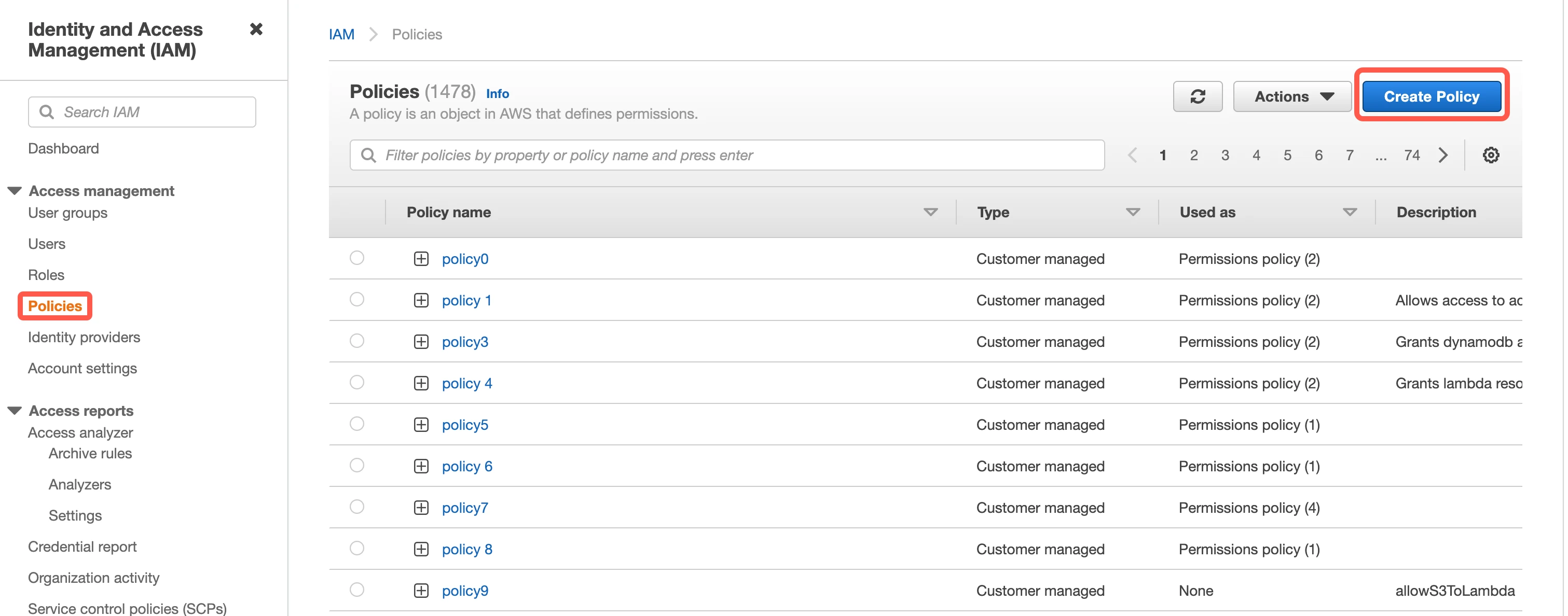
Go to the JSON tab.

Copy the following policy and paste it into the visual editor. Replace
{your-bucket-name}with the name of your S3 bucket. After that, click Next: Tags.{ "Version": "2012-10-17", "Statement": [ { "Effect": "Allow", "Action": [ "s3:GetBucketLocation", "s3:GetObject", "s3:ListBucket" ], "Resource": [ "arn:aws:s3:::{your-bucket-name}/*", "arn:aws:s3:::{your-bucket-name}" ] } ] }(Optional) If you use a customer-managed KMS key, add the following policy to the Action section of the IAM policy to provide read access to the encrypted files.
"Action": [ "kms:Decrypt", "kms:GenerateDataKey" ]In the Add tags step, you can optionally add custom tags that will be associated with your bucket. Click Next: Review.
In the Review policy step, specify the name of your policy, for example "Fivetran-S3-Access", then click Create policy.

(Optional) Access using IAM role
Find External ID
In the connection setup form, find the automatically-generated External ID and make a note of it. You will need it to create an IAM role in AWS.
The automatically-generated External ID is tied to your account. If you close and re-open the setup form, the ID will remain the same. You can keep the tab open in the background while you configure your source for convenience.
Create IAM role
Go to Roles, then click Create role.
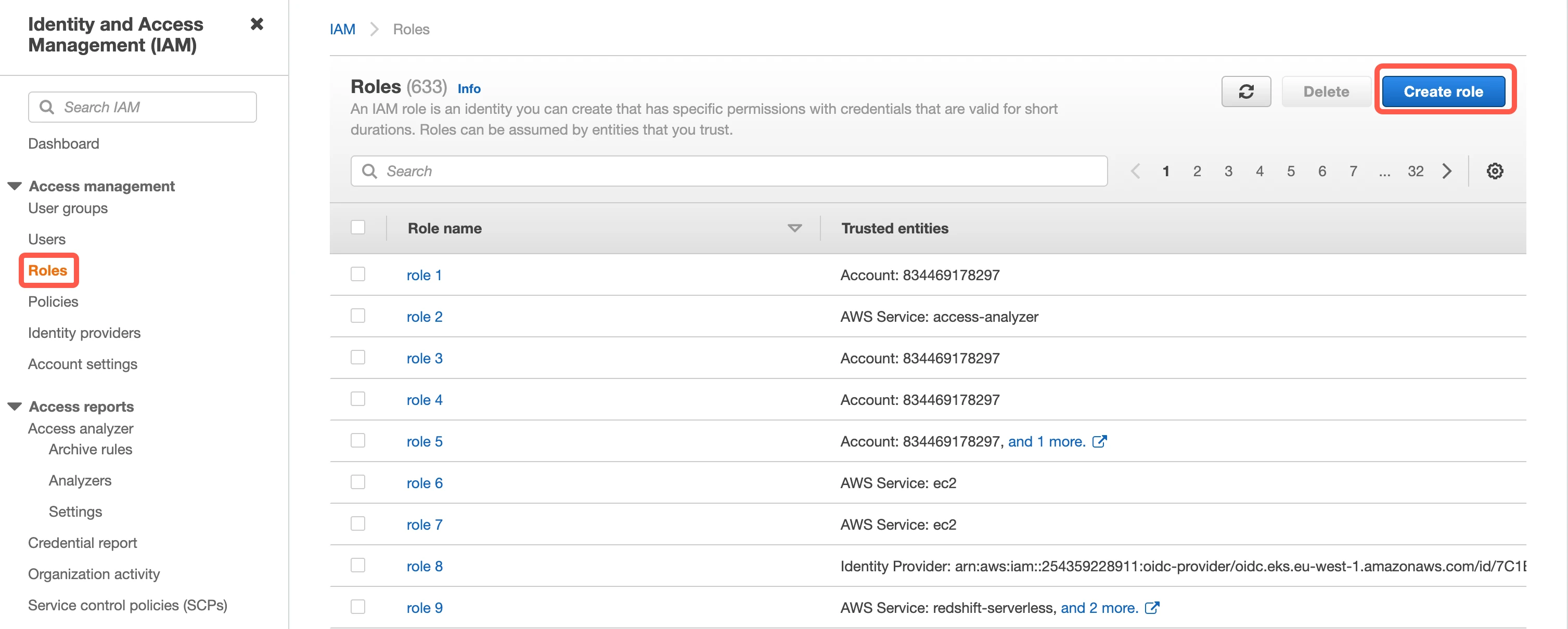
Select AWS account, then enter Fivetran’s AWS VPC Account ID,
834469178297, in the Account ID field.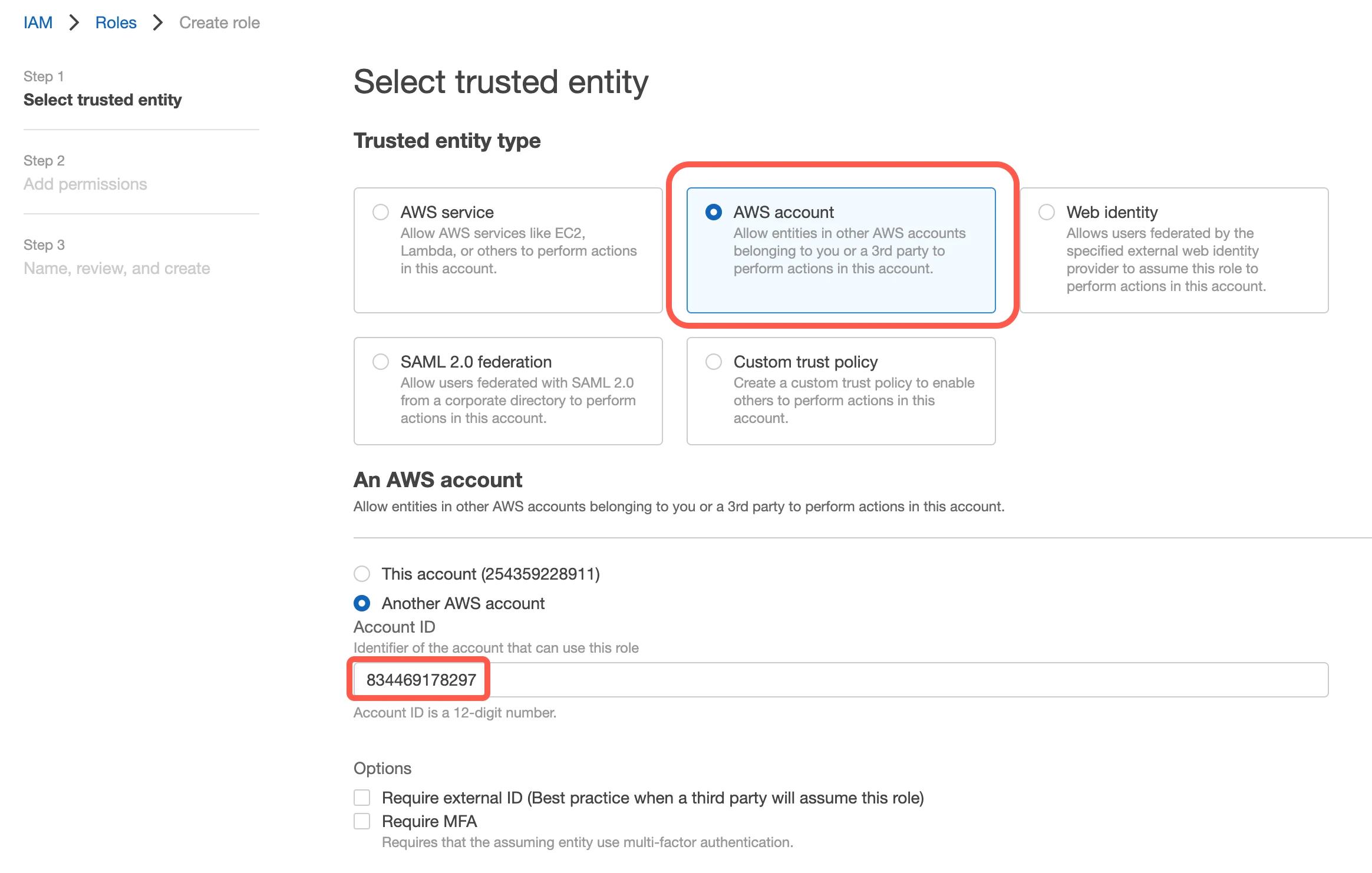
Select the Require external ID checkbox and enter the External ID you found above, then click Next.
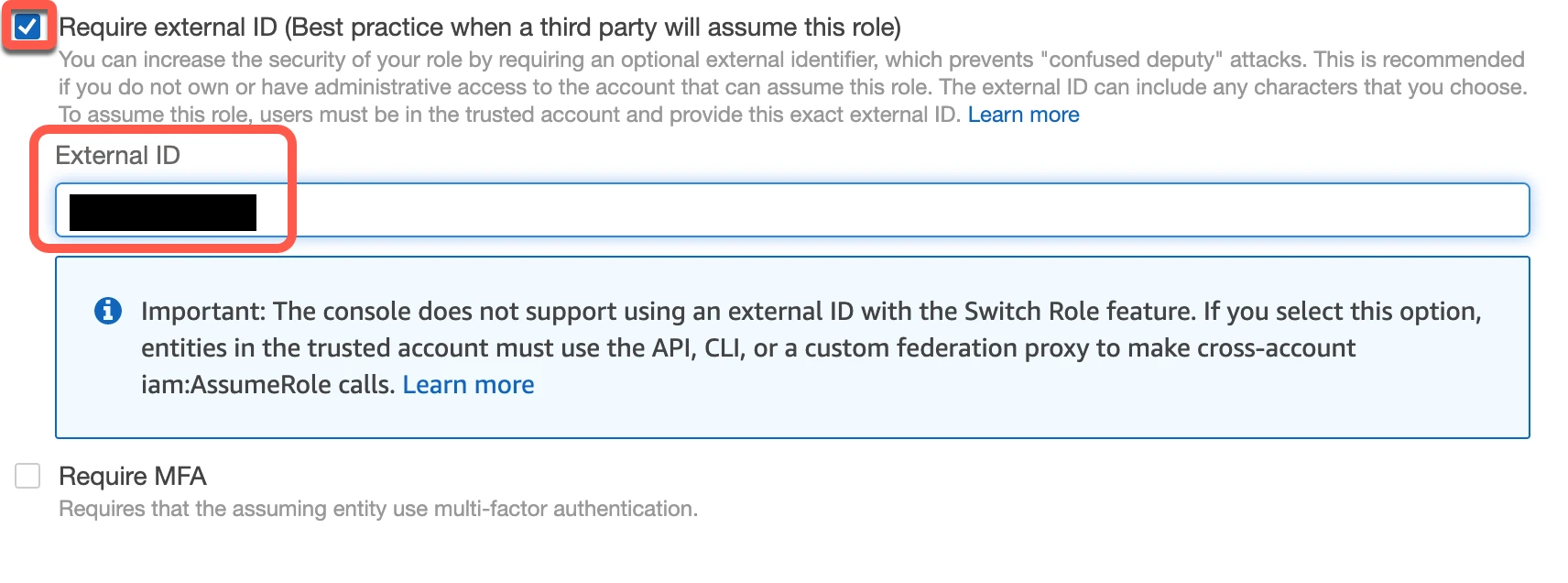
In the Add permissions step, select the "Fivetran-S3-Access" policy you created, then click Next.
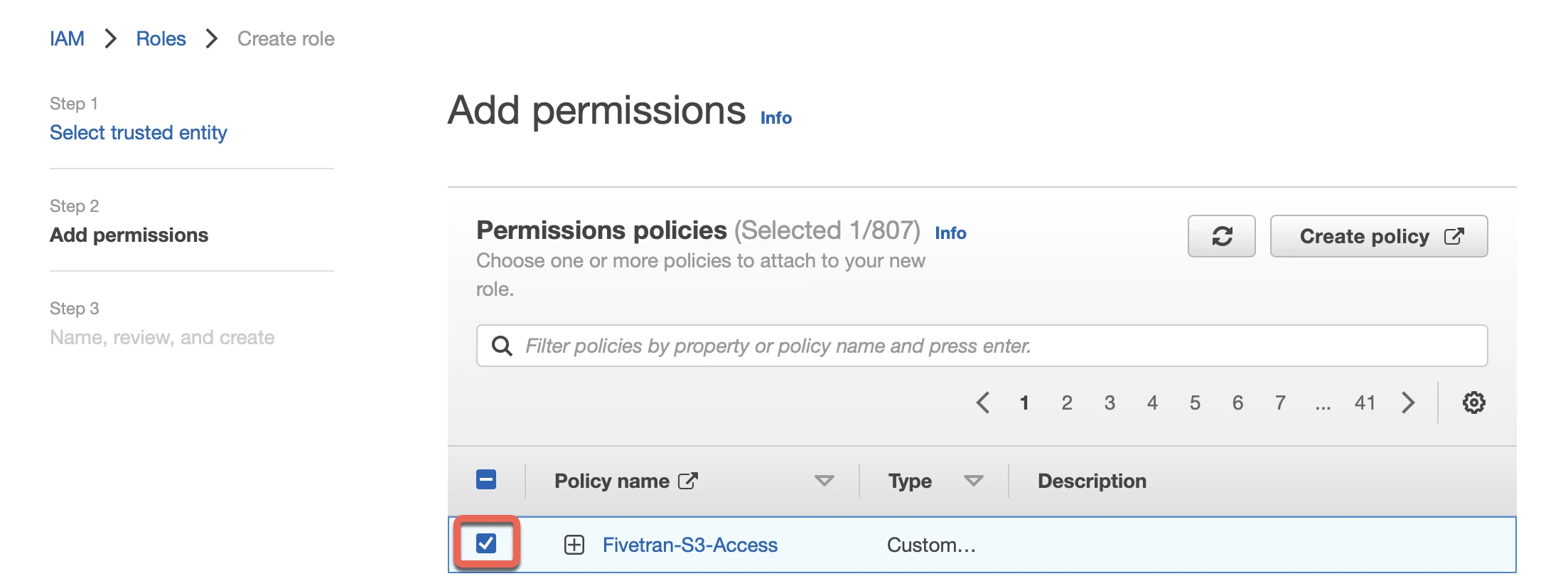
In the Name, review, and create step, specify the role name, for example "Fivetran", then click Create role at the bottom of the page.
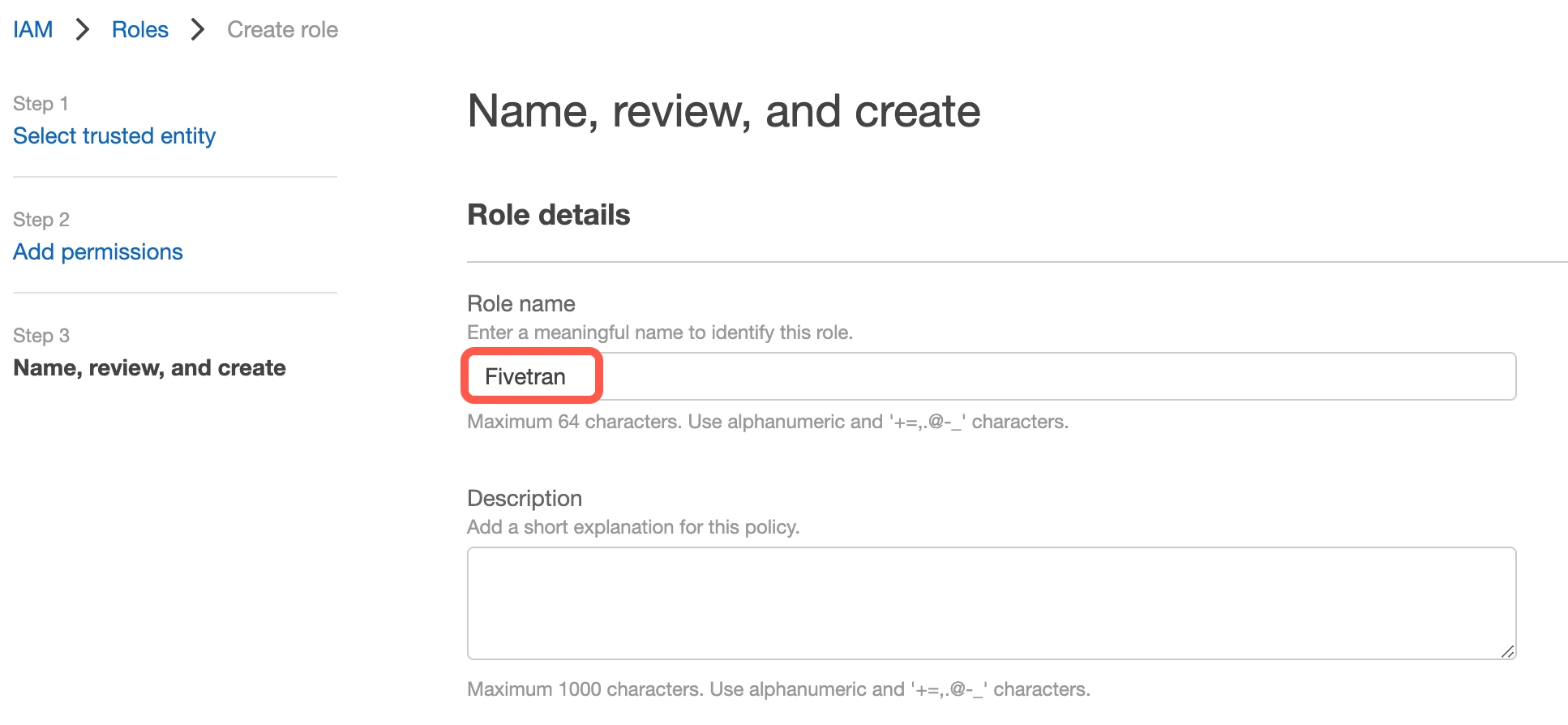
Click the Fivetran role you created.

On the Summary page for the role, find the ARN and make a note of it. You will need it to configure Fivetran.

If you want to re-use an existing IAM role created for Fivetran account, you need to edit the trust policy for the same role. You can then add another external ID to the JSON policy or copy the following policy and paste it in your JSON tab:
{ "Version": "2012-10-17", "Statement": [ { "Effect": "Allow", "Principal": { "AWS" : "arn:aws:iam::834469178297:user/gcp_donkey" }, "Action": "sts:AssumeRole", "Condition": { "StringEquals": { "sts:ExternalId": [ "external-id-1", "external-id-2" ] } } } ] }
(Optional) Set permissions
You can specify permissions for the Role ARN that you designate for Fivetran. Giving selective permissions to this role will allow Fivetran to only sync what it has permissions to see.
Skip to the Configure AWS PrivateLink step.
(Optional) Access using key and secret
You can skip this step if you already have an access key and secret.
Create user
You can skip this step if you already have a user having access to the bucket.
Open your Amazon IAM console.
Go to Users, then click Add users.

Enter the User name, then click Next.
Select the Attach policies directly option, then select the "Fivetran-S3-Access" policy you created.
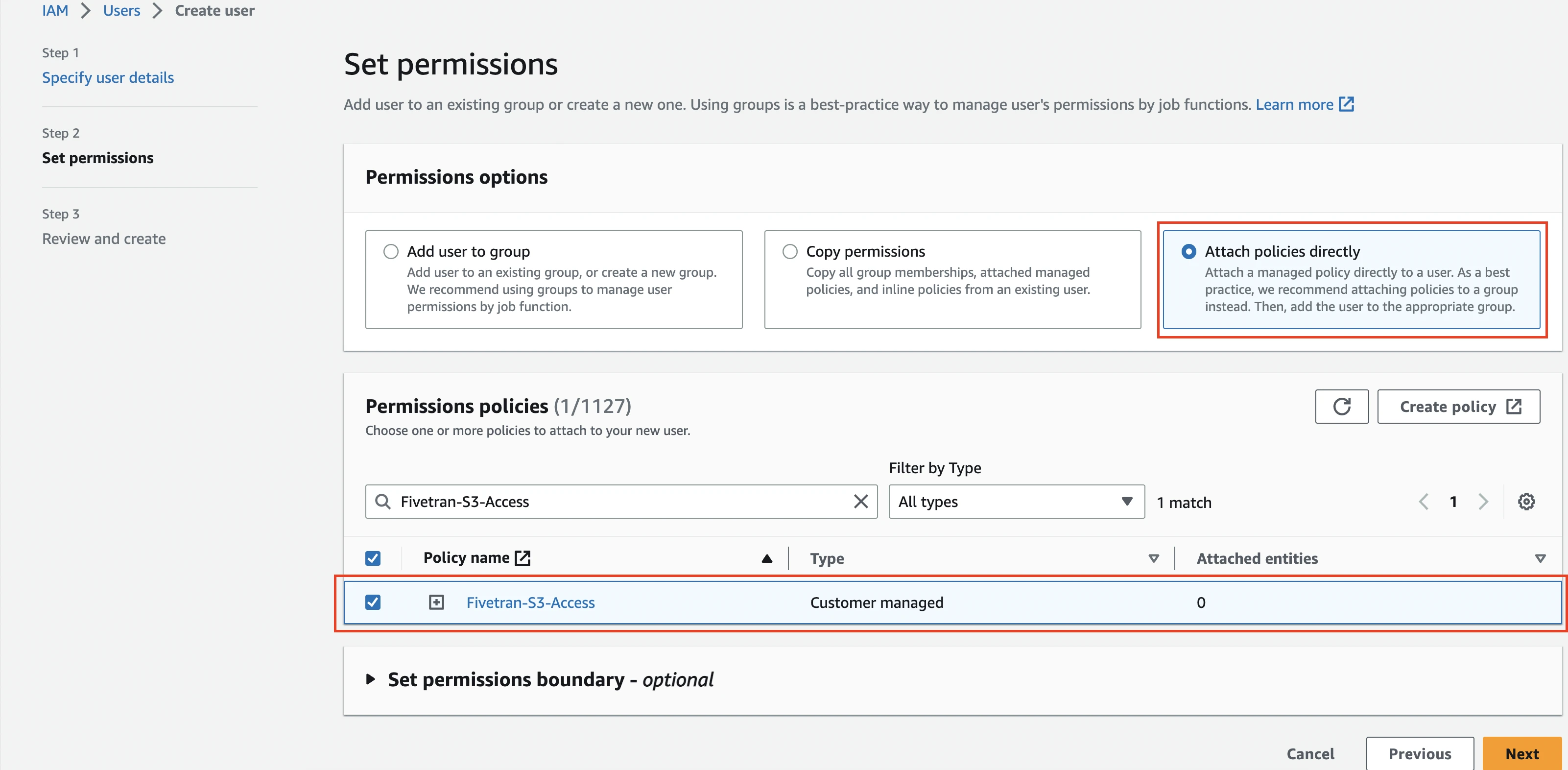
Click Next, then click Create user.
Generate access key and secret
In the Users tab, open the User you created.
Go to Security credentials tab and navigate to the Access keys section.
Click Create access key.
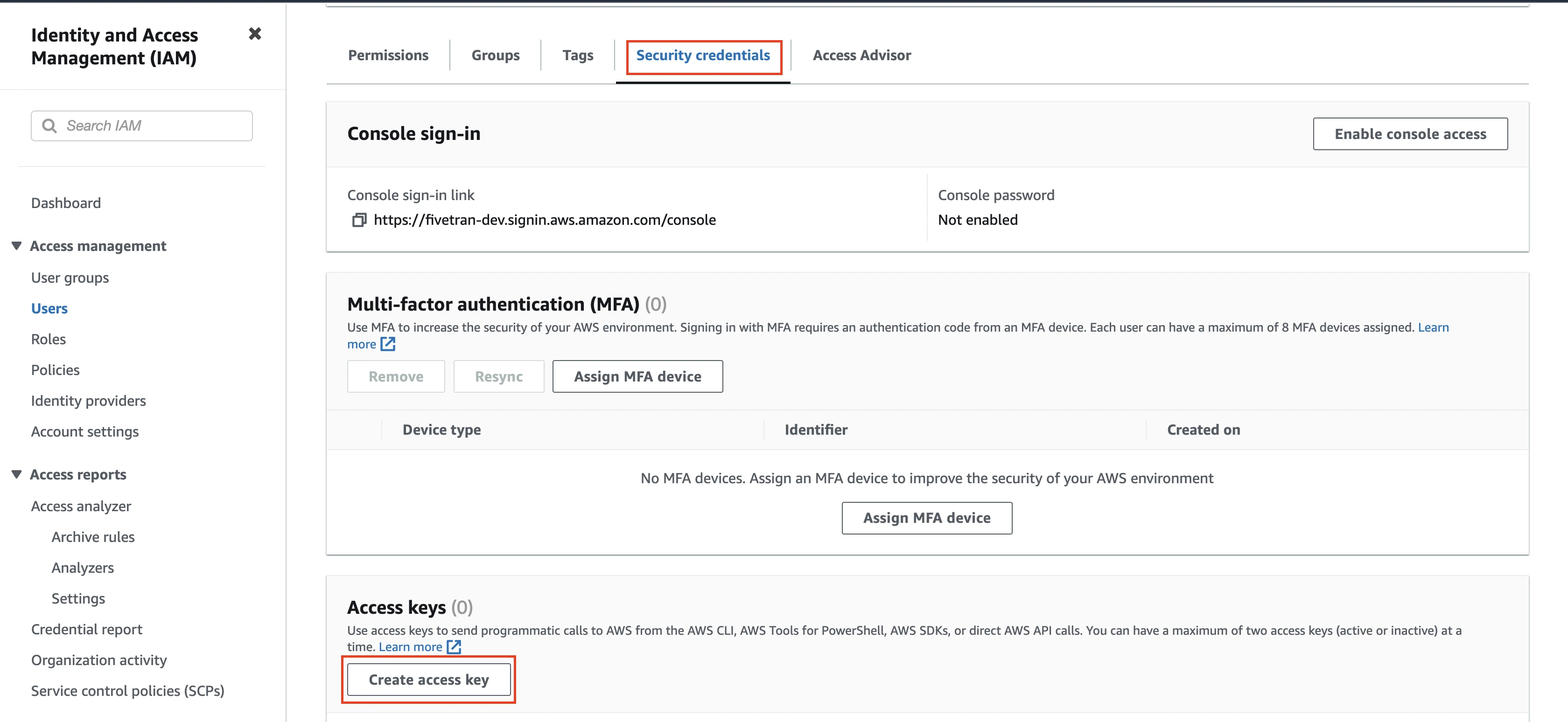
From the Use Case options, select the Third-party service option and then click Next.
Enter a Description tag value and then click Create access key.
Copy the Access key and Secret access key values. You will need them to configure Fivetran.
(Optional) Configure AWS PrivateLink
You must have a Business Critical plan to use AWS PrivateLink.
AWS PrivateLink allows VPCs and AWS-hosted or on-premises services to communicate with one another without exposing traffic to the public internet. PrivateLink is the most secure connection method. Learn more in AWS PrivateLink documentation.
Follow our AWS PrivateLink setup guide to configure PrivateLink for your S3 bucket.
There are two ways in which you can provide Fivetran access to your data, using IAM policies to control access to S3 buckets(recommended) or using access points.
By default, you cannot configure PrivateLink if you want to use the Hybrid Deployment model. However, if you want to configure PrivateLink with Hybrid Deployment, see the Gateway endpoints for Amazon S3 documentation. With a gateway endpoint, you can access Amazon S3 from your VPC without an internet gateway or NAT device for your VPC.
(Optional) Configure access point
Create access point
Create an access point to provide Fivetran access to your S3 bucket.
Open your S3 console.
On the left navigation pane, click Access Points.
Select the access point.
Go to the Properties tab. Make a note of the Access Point alias. You will need it to configure Fivetran.
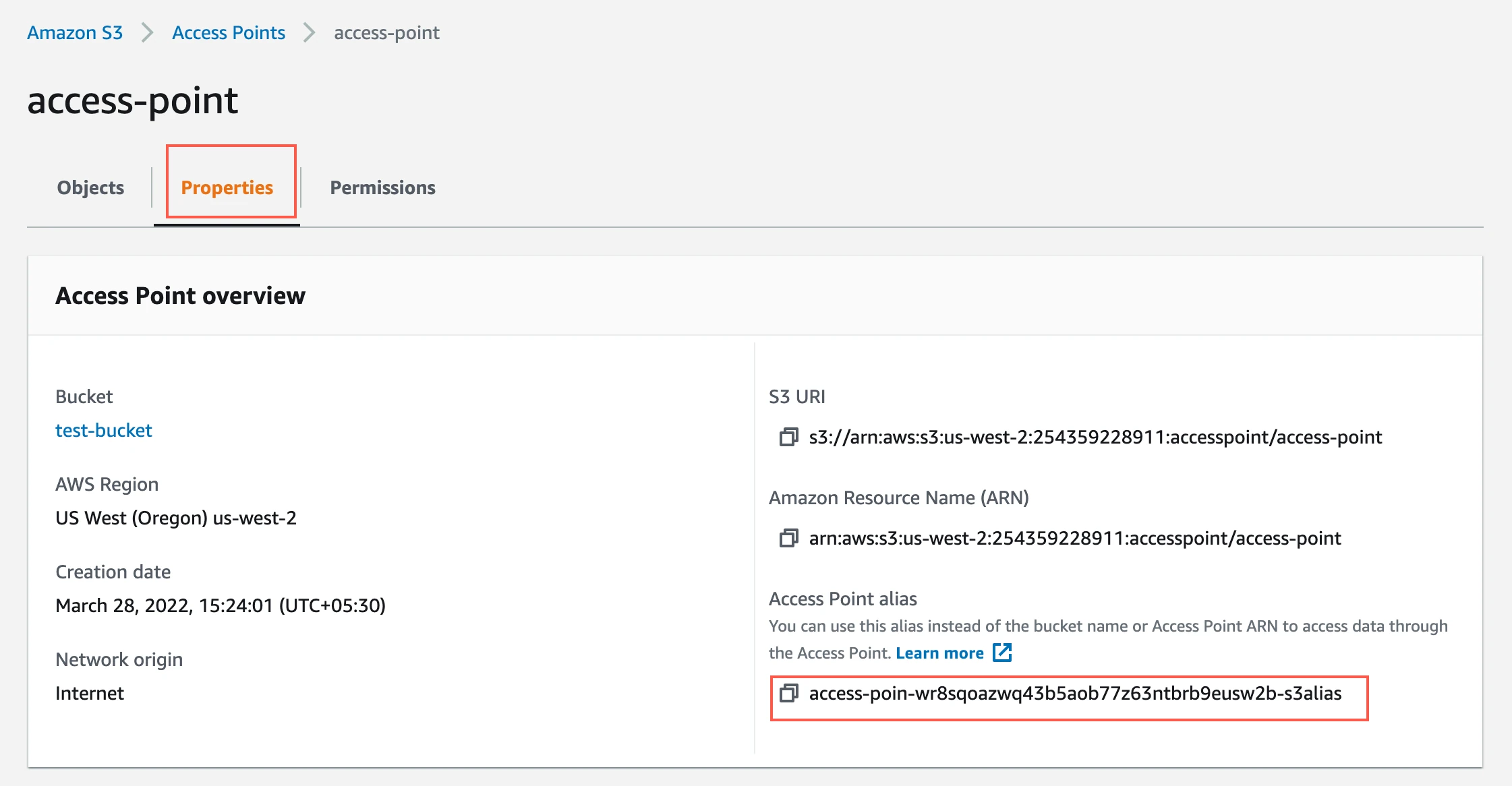
To provide your bucket access to the access point, copy the following into the bucket policy you created. Replace
{account-number}with your AWS account number,{role-name}with the role name that you created,{your-bucket-name}with the S3 bucket name that you used to configure the access point,{access-point-region}with the AWS region in which you created the access point, and{your-access-point}with the name of the access point you created.{ "Version": "2012-10-17", "Statement": [ { "Effect": "Allow", "Principal": { "AWS": "arn:aws:iam::{account-number}:role/{role-name}" }, "Action": [ "s3:GetObject", "s3:ListBucket" ], "Resource": [ "arn:aws:s3:::{your-bucket-name}", "arn:aws:s3:::{your-bucket-name}/*" ], "Condition": { "StringLike": { "s3:DataAccessPointArn": "arn:aws:s3:{access-point-region}:{account-number}:accesspoint/{your-access-point}" } } } ] }
Create an IAM policy for access point
Create a new access point policy. Copy the following policy and paste it in the JSON tab. Replace {access-point-region} with the region in which you created the access point, {account-number} with your account number, and {your-access-point} with the name of the access point you created.
{ "Version": "2012-10-17", "Statement": [ { "Effect": "Allow", "Action": [ "s3:GetObject", "s3:ListBucket" ], "Resource": [ "arn:aws:s3:{access-point-region}:{account-number}:accesspoint/{your-access-point}", "arn:aws:s3:{access-point-region}:{account-number}:accesspoint/{your-access-point}/*" ] } ] }
Finish Fivetran configuration
Depending on your Access approach, do the following:
- If you selected IAM Role, enter the Role ARN you created.
- If you selected Access Key and Secret, enter the Access Key ID and Access Key Secret you created.
(Optional) Click Run connection test to validate the login credentials and connection to the AWS S3.
You can skip this intermediate test and proceed to the next step. However, if you choose to skip, we will perform this test once you have finished your configuration.
Configure files
(Optional) Base folder path - Use the folder path to specify a portion of the file system in which you'd like Fivetran to look for files. We examine files under the specified folder and all of its nested subfolders for files we can sync. If you don't provide a prefix, we'll look through the entire file system for files to sync.
File Mapping - You can map the files to a destination using the following options:
Define per table
Select Define per table.
Click + Add files to specify destination tables and their corresponding file name pattern.
Table name - Use names that are unique across all S3 connections within the same destination schema.
(Optional) File pattern - Use a regular expression as the file pattern to determine whether to sync specific files. The pattern you specify applies to everything under the prefix (base folder path). If you want to sync everything under the prefix, leave this field blank.
For example, if under the prefix you have a folder
data, which has sub-folders,subFolder1,subFolder2, etc. These sub-folders have JSON files with the formatreport_03/12/2050.json. Use the following regex patterns to decide whether or not to sync specific files:data/.*matches all files in the data folder, including those in subfolders.data/.*jsonmatches all JSON files in the data folder, including those in subfolders.data/subFolder2/report_.*\.jsonmatches all the JSON files in thesubFolder2folder that have a name that starts with the prefixreport_.. For example,report_file.json.report_\d{2}/\d{2}/\d{4}\.jsonmatches all the JSON files that begin with the prefixreport_and are followed by a date format ofDD/MM/YYYYorMM/DD/YYYY. For example,report_03/12/2050.json.We recommend that you test your regex.
(Optional) Click Preview Files to validate the file pattern.
You can skip this intermediate test and proceed to the next step. However, if you choose to skip, we will perform this test once you have finished your configuration.
(Optional) Archive file pattern - Use a regular expression to filter and sync files from archived folders. We sync the files in compressed archives with filenames matching the specified pattern. For example, if you specify the archive folder pattern as
.*json, we will sync only the files that end in a .json file extension from the archive folder.You need to configure archive patterns per table. This is useful when an archive folder contains files following different naming patterns, allowing you to route each type to a specific destination table based on its pattern.
For example, if the archive folder contains
test12.jsonandcheck12.json, you can configuretest.*\.jsonas archive pattern for Table1 to sync onlytest12.jsonto Table1, andcheck.*\.jsonfor Table2 to sync onlycheck123.jsonto Table2.Click Save.
Dynamically extract tables
Select Dynamically extract tables.
Use this option to dynamically extract table names from file paths using a regular expression with a named capture group.
Table extraction pattern - Specify a regular expression with a named capture group
(?<table>...)to extract the table name from matching file paths.For example, if your files follow a naming pattern like
20250101/report/customers.csv,20250101/report/orders.csv, etc., you can use the pattern\d{8}/report/(?<table>\w+)\.csv. Fivetran will automatically create separate destination tables for each unique table name extracted from the pattern (e.g.,customers,orders). To learn more about Dynamic File Mapping, see How to use Dynamic File Mapping?We recommend that you test your regex to ensure it correctly captures the table name.
(Optional) Click Preview to validate the regex pattern and see which table names will be extracted from your files. The preview displays one matched file per table with the corresponding table name extracted from the file path.
The preview displays the table names extracted from your files. These names will be converted according to Fivetran's naming conventions when synced to your destination. For more information, see our naming conventions documentation.
Any new tables observed post-setup (i.e. previously unseen table values that match your pattern) will be added automatically. You can control this behavior using Schema change settings.
Format
File Type - We process all files as the selected file type. Use the File Pattern field to select the file extensions you want to sync.
If your file type is XML, we load your XML data into the
_datacolumn without flattening it.If your file type is CSV or TSV then enter the following details:
- (Optional) Delimiter - Specify the delimiter used in your CSV file. If your CSV file uses a custom delimiter, replace the default comma
,with your specific delimiter. For example, if your file is tab-delimited, enter\t, or if it’s pipe-delimited, enter|. If you leave this field blank, we’ll attempt to detect the delimiter for each file automatically. However, note that automatic detection may not work in all cases. If your files sync with an incorrect number of columns or use a unique delimiter, consider specifying the delimiter. You can store files with different delimiters in the same folder. For more details on how delimiter inference works, see our documentation. - Quote character - Typically, CSVs use double quotes
"to enclose a value. Set the toggle to off if you don’t want to use an enclosing character. - Non-Standard escape character - Set the toggle to ON if your CSV generator uses non-standard ways of escaping characters like newline, delimiter, etc. Not standard in CSVs.
- Null Sequence - Set the toggle to ON if your CSVs use a special value indicating null. Specify the value indicating null only if you are sure your CSVs have a null sequence. Typically, CSVs have no native notion of a null character. However, some CSV generators have created one, using characters such as
\Nto represent null. - Skip Header Lines - Use this option to skip over a fixed number of header lines at the beginning of your CSV files. Set the toggle to ON, and then in the Number of skipped header lines field, specify the number of header lines you want to skip.
- Skip Footer Lines - Use this option to skip over a fixed number of footer lines at the end of your CSV files. Set the toggle to ON, and then in the Number of skipped footer lines field, specify the number of footer lines you want to skip.
- Headerless files - Set the toggle to ON if your CSV-generating software doesn't provide a header line. Fivetran can generate generic column names and sync data rows with them.
- Line Separator - Line separators are used in CSV files to separate one row from the next. By default, we use the new line character
\nas the line separator. If you use a different line separator for your CSV files, replace\nwith your custom line separator.
If your file type is JSON or JSONL, then select the following:
JSON Delivery Mode - Use this option to choose how Fivetran should handle your JSON data.
- If you select Packed, we load all your JSON data into the
_datacolumn without flattening it. - If you select Unpacked, we flatten one level of columns and infer their data types.
If your file type is XLS/XLSX/XLSM, then enter the following details:
By default, we analyze your spreadsheet to identify the cell reference. You can also opt to enter a cell reference of your choice by using the Manually provide cell reference toggle. We use the cell reference to sync all contiguous data starting from the top-left cell in all the spreadsheets matching the name.
Analyze sheet: Identify the sample file you would want to sync. We analyze and identify the eligible data sets. To determine the cell reference correctly, do the following:
- In the Spreadsheet to find data to be synced field, enter the S3 URI of one of your Excel files from the root folder. You can find the S3 URI as illustrated in the image below:
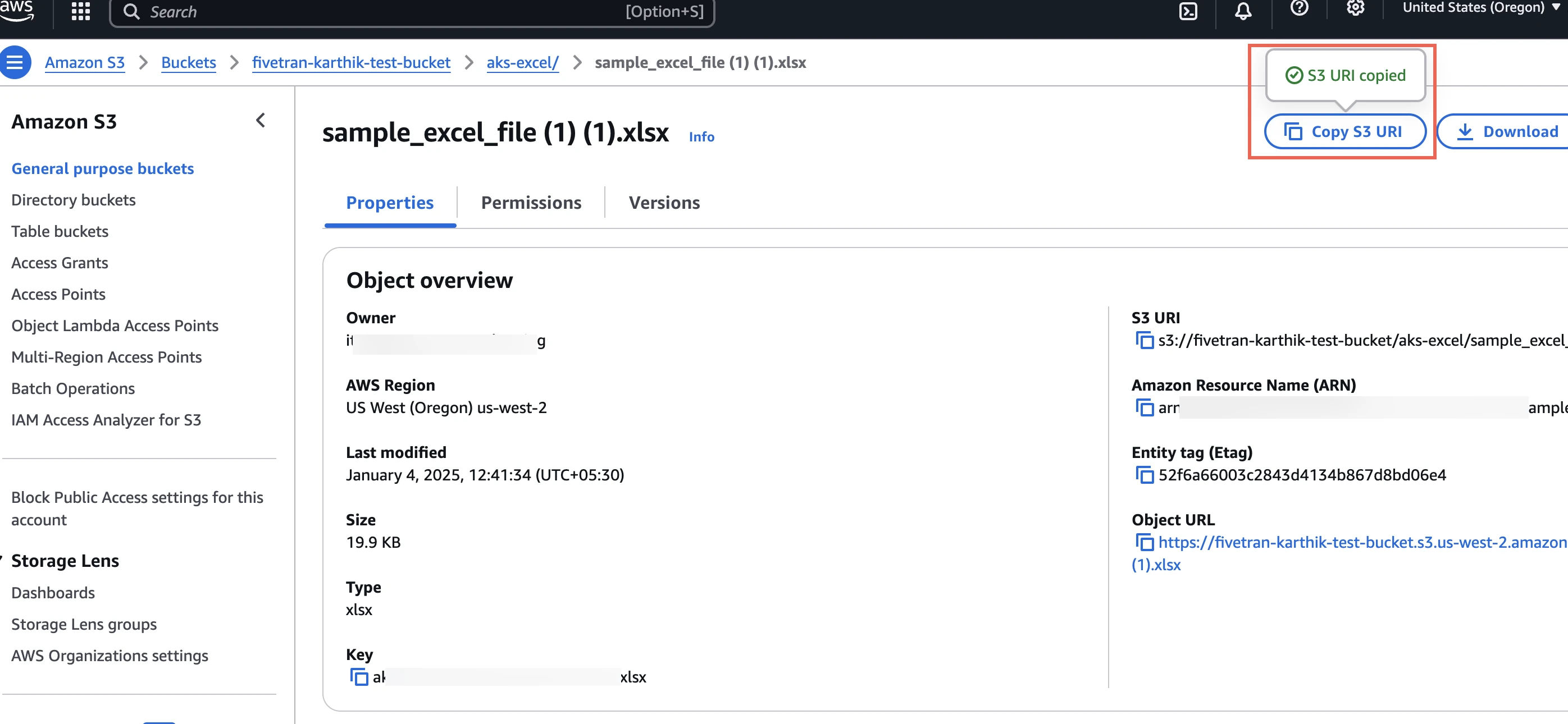
- Click Analyze sheet.
- In the Cell reference for syncs drop-down menu, select the cell reference.
- In the Spreadsheet to find data to be synced field, enter the S3 URI of one of your Excel files from the root folder. You can find the S3 URI as illustrated in the image below:
Set the Manually provide cell reference toggle to ON to enter the cell reference.
- Manual Cell Reference: Enter the cell reference in the
'<sheetName>'!<startColumnName><startRowName>format. For example, if you want to sync data starting from cell 'C3' of the 'Data2' worksheet, enter'Data2'!C3.
- Manual Cell Reference: Enter the cell reference in the
Learn more about syncing Excel files.
- (Optional) Delimiter - Specify the delimiter used in your CSV file. If your CSV file uses a custom delimiter, replace the default comma
Primary Key used for file process and load - Use this option to let Fivetran know how you'd like to update the files in your destination. When you modify a previously synced file, the option you select determines if we should replace the rows in the destination table or append new rows to the table:
- If you select Upsert file using file name and line number, we will upsert your data using the surrogate primary keys
_fileand_line. If a file has a unique name, we will sync the data for that file as new data. - If you select Append file using file modified time, we will upsert your files using surrogate primary keys
_file,_line, and_modified. You can track the full history of a file or set of files, and your files will have a combination of old and new data or data that is updated periodically. - If you select Upsert file using custom primary key, you can keep the most recent version of every record, and your files will have a combination of the old and new data or data that is updated periodically. You can choose the primary keys you want to use after you save and test.
You can modify the primary keys only if your initial sync fails. If your initial sync is successful, the option to modify the primary keys is not available.
- If you select Upsert file using file name and line number, we will upsert your data using the surrogate primary keys
Additional options
Compression - If your files are compressed but do not have extensions indicating the compression method, you can decompress them according to the selected compression algorithm. If all of your compressed files are correctly marked with a matching compression extension (.bz2, .gz, .gzip, .tar, or .zip), you can select infer. If you select uncompressed, we do not decompress the files and sync the uncompressed files. If you choose a compression format, we decompress every file using the format you select. For example, if you have an automated CSV output system that GZIPs files to save space but saves them without a .gzip extension, you can set this field to GZIP. We will decompress every file that we examine using GZIP.
Error Handling - Use the error handling option to choose how to handle errors in your files. If you know that your files contain some errors, you can choose to skip poorly formatted lines.
If you select skip, we ignore improperly formatted data within a file, allowing you to sync only valid data.
If you select fail, we fail the sync with an error when finding any improperly formatted data.
We recommend that you select fail unless you are sure that you have undesirable, malformed data.
You will receive a notification on your Fivetran dashboard if we encounter errors.
(Optional) PGP Encryption Options - Use this option to sync PGP encrypted files. Set the toggle to ON and specify the following:
- PGP Private Key - Upload the PGP secret key as an attachment.
- (Optional) Passphrase - Enter the passphrase you used to generate the key.
- (Optional) Signer's Public Key - Upload the signer's public key as an attachment. This key is used to verify the files.
- For PGP decryption processes, we strictly comply with the RFC4880 standard. We support syncing only base64 encoded files.
- To support PGP encryption on compressed files, the file name must contain both a valid compression extension and the .pgp encryption extension. For example: sample.csv.zip.pgp — where .zip is the compression extension and .pgp is the encryption extension.
(Optional) List Strategy - Select the listing strategy you want to use:
complete_listing - The default option, where we list all the new and modified files from the bucket.
time_based_pattern_listing - You can opt to use this strategy if your files are named based on the date or time they are added to the bucket. If you add new files in lexicographic order to the bucket, in each sync, we try to identify a time-based pattern. We only list and sync the files that are lexicographically greater than the last file synced in the previous sync.
If we are unable to identify a time-based pattern, we use the default option.
(Not applicable to Hybrid Deployment) If you want to connect using AWS PrivateLink, set the Require PrivateLink toggle to ON.
By default, we use PrivateLink to connect if your S3 bucket and destination are in the same region. Enabling this option ensures that we always use PrivateLink to connect. If the regions are different, Fivetran won't create the connection.
(Hybrid Deployment only) If your destination is configured for Hybrid Deployment, the Hybrid Deployment Agent associated with your destination is pre-selected for the connection. To assign a different agent, click Replace agent, select the agent you want to use, and click Use Agent.
Click Save & Test. Fivetran will take it from here and sync your data from your Amazon S3 bucket.
Fivetran tests and validates the Amazon S3 connection. On successful completion of the setup tests, you can sync your Amazon S3 data to your destination.
Setup tests
Fivetran performs the following Amazon S3 connection tests:
The Validating Bucket Name test validates the bucket name you specified in the setup form and checks the bucket name to ensure that it does not contain any prefix or folder path characters.
The Connecting to Bucket test validates the connection and checks the accessibility of your S3 bucket.
The Validating External ID test validates if the external ID you specified in the setup form is correctly assigned and checks whether you have configured a security role using the external ID. We perform this test only if you select IAM Role in the Access approach field.
Define files per table mode tests:
- The Finding tables test validates if you have specified at least one table in the files field to set up the connection.
- The Validating File Pattern Regex test validates the file pattern regex you specified in the setup form. This test ensures that the regex pattern correctly matches files in your S3 bucket and routes them to the appropriate destination tables. We perform this test only if you specify a regex in the File Pattern field.
- The Validating Archive Pattern test validates the archive pattern regex you specified in the setup form. This test verifies that the regex pattern correctly filters files within compressed archives and routes them to their designated destination tables. We perform this test only if you specify a regex in the Archive File Pattern field.
- The Finding Matching Files test checks if the connector can successfully retrieve a minimum of one sample file and a maximum of five sample files for each of the tables you specified in the setup form.
Dynamically extract tables mode tests:
- The Validating Table extraction pattern test validates the regex pattern you specified in the Table extraction pattern field. This test ensures that the pattern is not empty, the pattern is of valid regex syntax and the pattern contains exactly one named capture group called
table. - The Finding Matching Files test checks if the connector can successfully discover files using the table extraction pattern. The test shows up to five tables with up to three sample files per table. The table names displayed are extracted from your files and will be converted according to Fivetran's naming conventions when synced to your destination. For more information, see our naming conventions documentation.
- The Validating Table extraction pattern test validates the regex pattern you specified in the Table extraction pattern field. This test ensures that the pattern is not empty, the pattern is of valid regex syntax and the pattern contains exactly one named capture group called
The Validating EscapeChar test validates the escape character you specified for your CSV files and checks the length of the character which must not be more than one. We perform this test only if you set the Non-standard character escaping? toggle to ON and specify an escape character in the Escape Character field.
The Validating Infer FileType test validates whether
inferis added as a value in thefile_typeparameter for connections created using the API. We perform this test only if you have set up your connector using the API.The PGP Support test validates whether the connector can successfully retrieve a minimum of one sample file and a maximum of ten sample files from the S3 bucket and decrypt them using the PGP keys you uploaded. We perform this test only if you set the PGP Encryption Options toggle to ON.
The Multi-Character Delimiter Support test validates the length of the delimiter, which must be within 15 characters. We perform this test only if you specify the delimiter for your CSV files in the Delimiter field.
The PrivateLink test validates whether your S3 bucket is in the same AWS Region as Fivetran. We perform this test only if you set the Require PrivateLink toggle to ON.
The tests may take a couple of minutes to complete.
Related articles
description Connector Overview